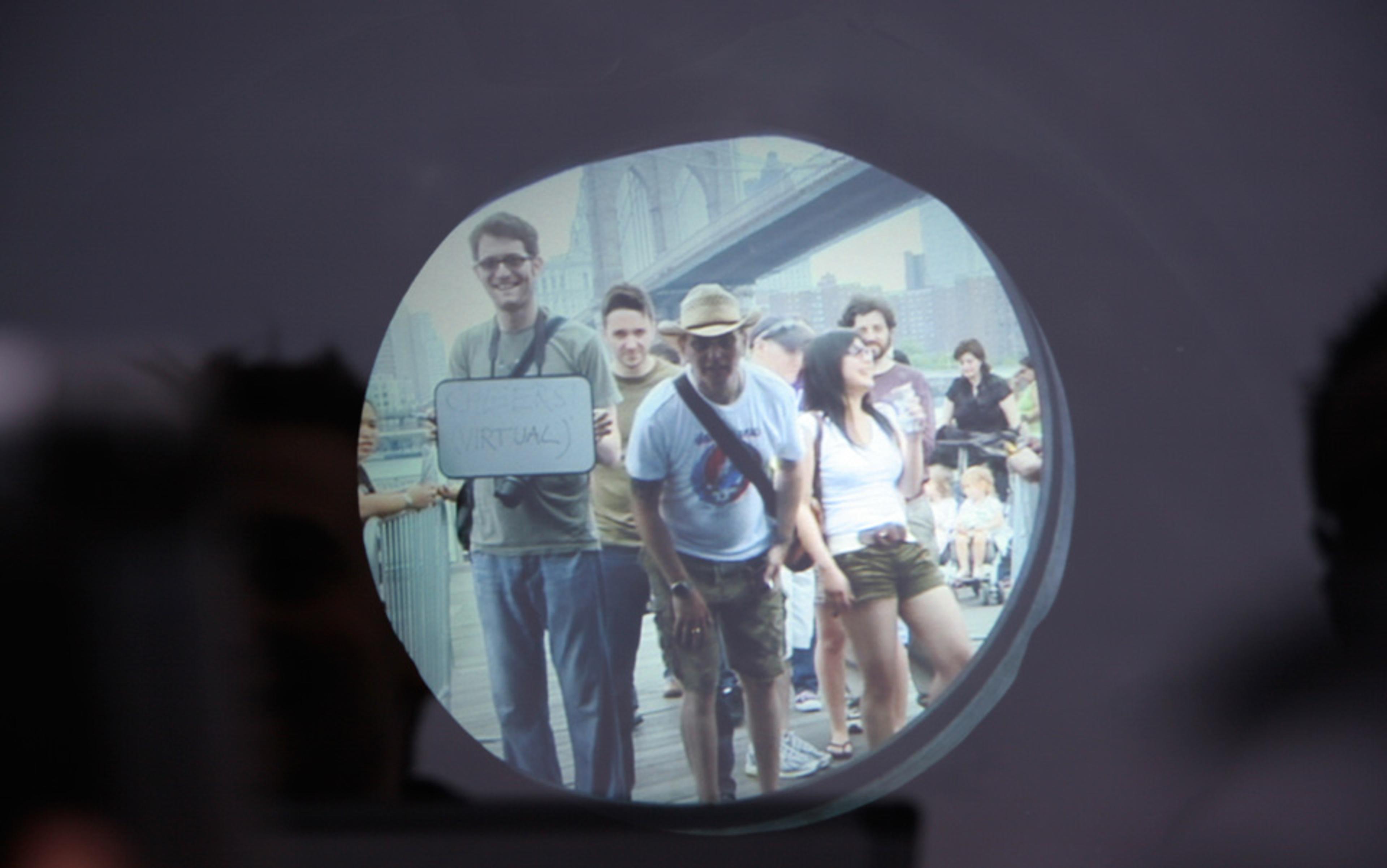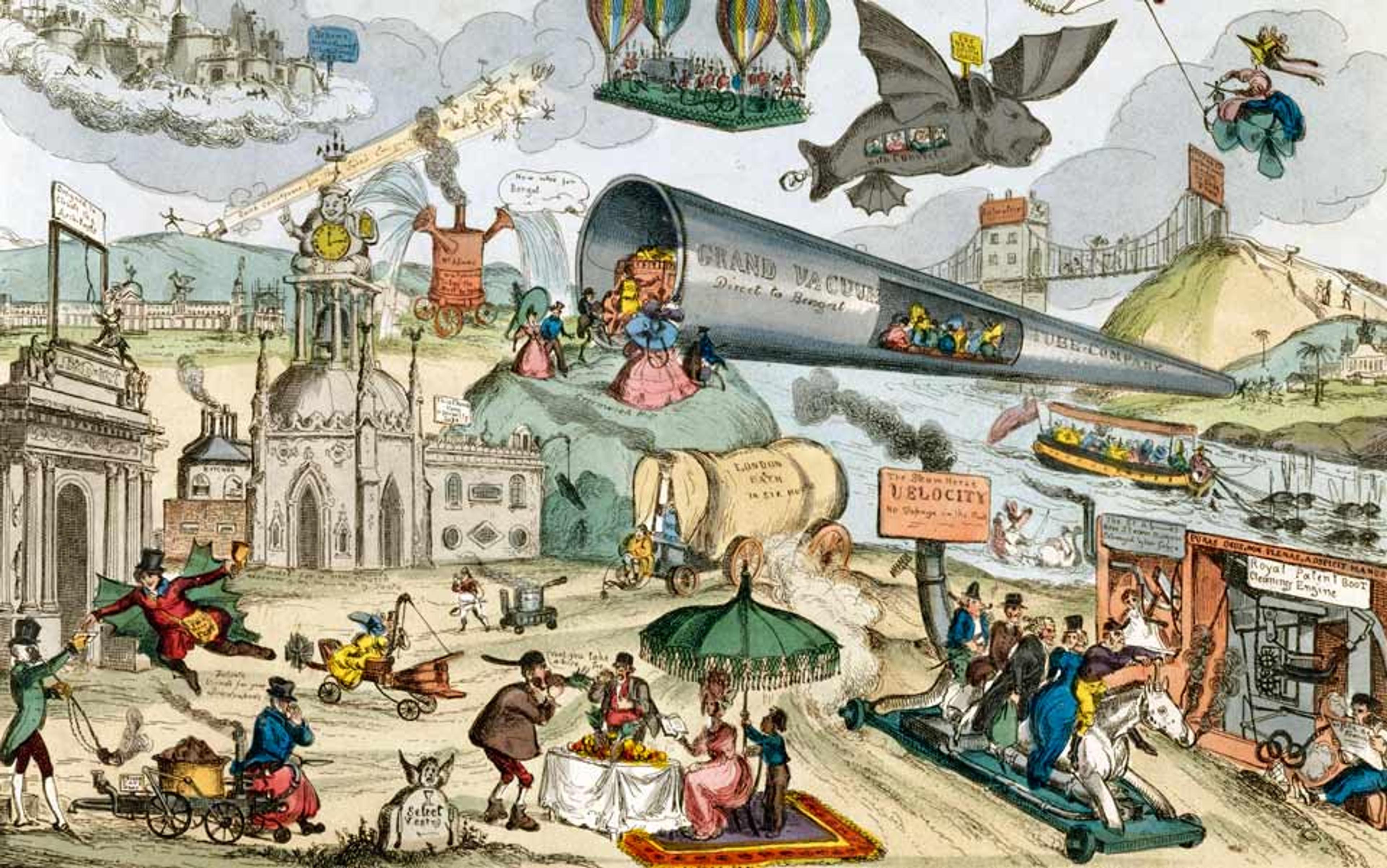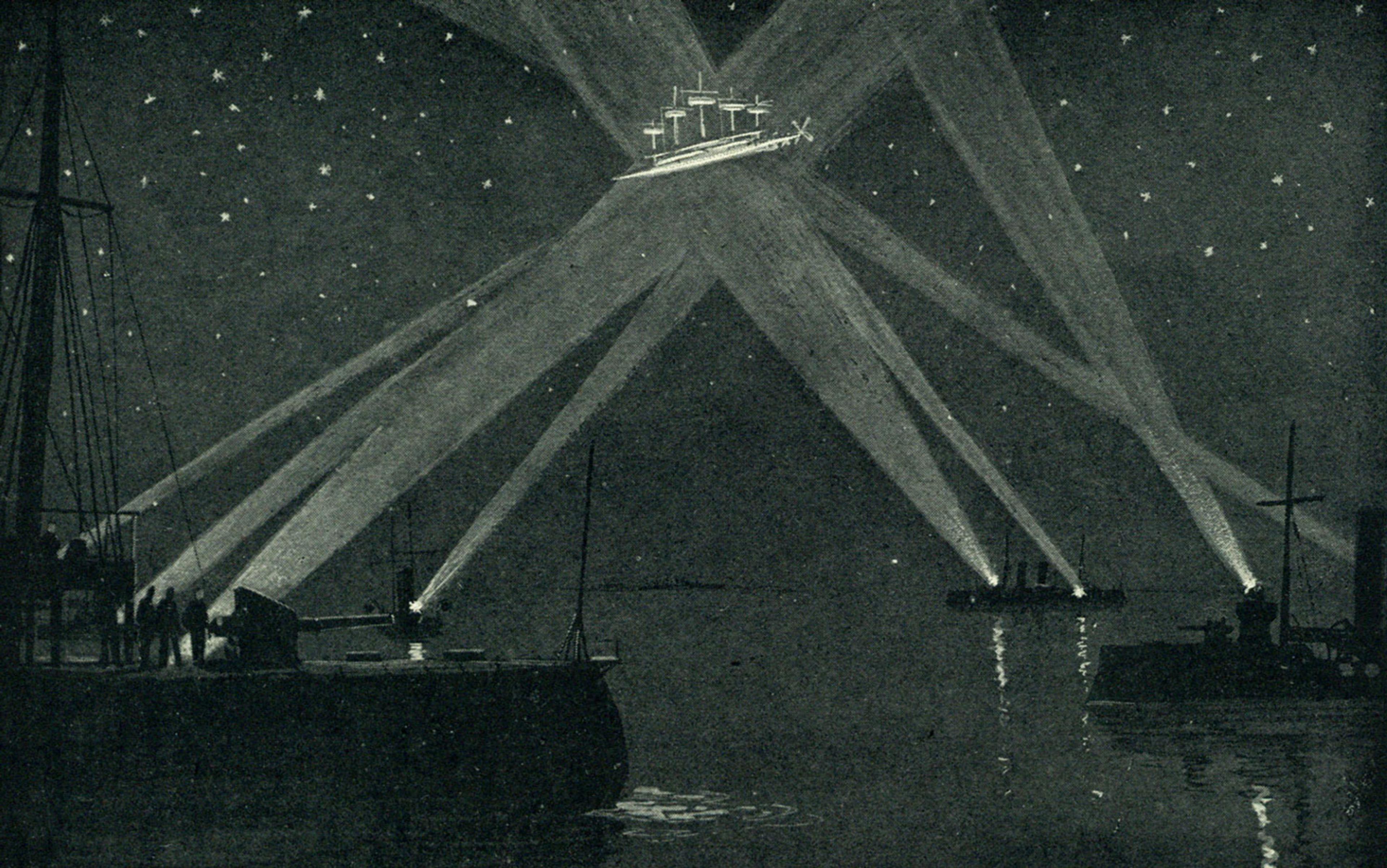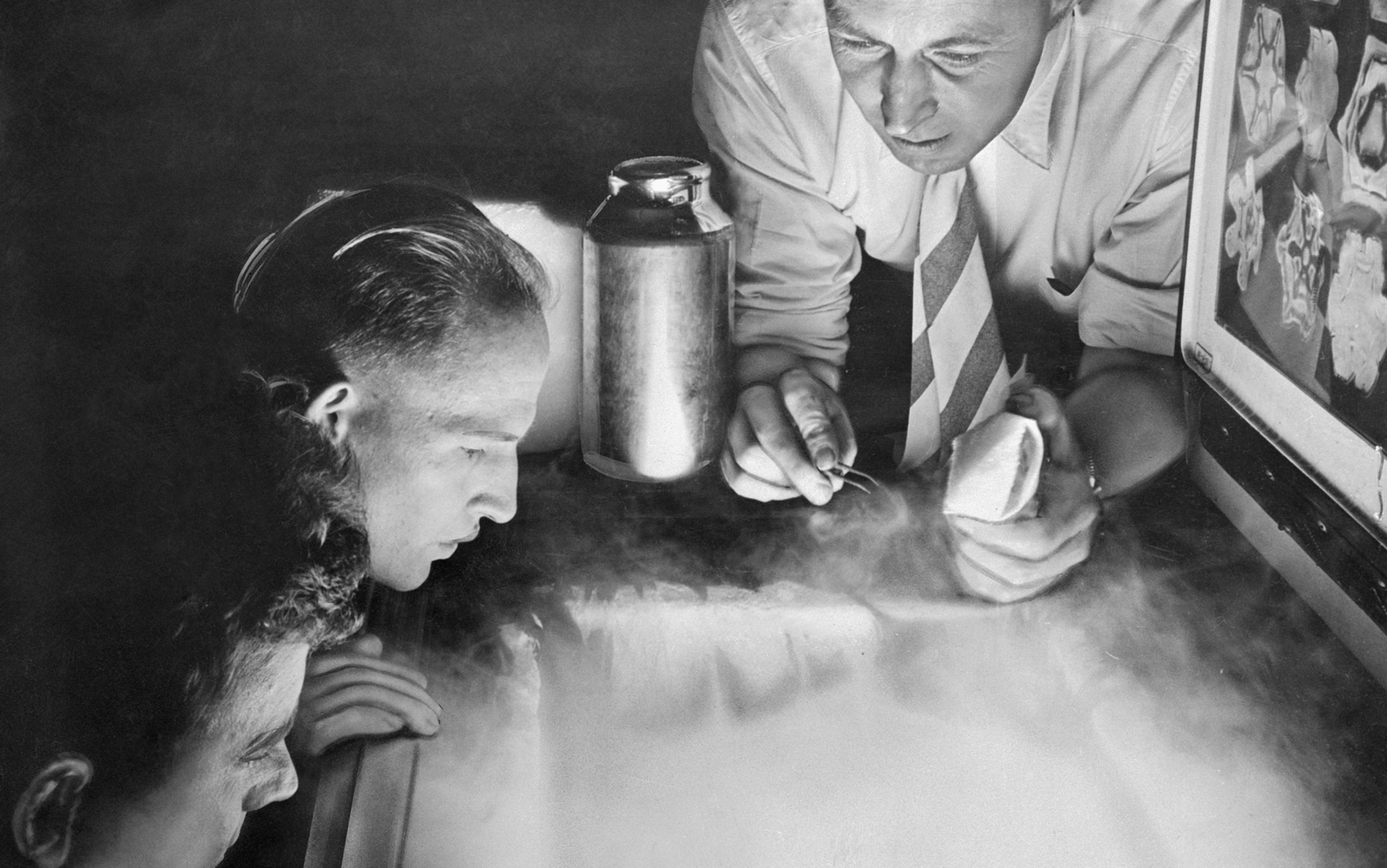Before the beginning of the 19th century, the future was only rarely portrayed as a very different place from the present. The social order, like the natural order, was supposed to be static, with everything in its proper place: as it had been, so it would be. When Sir Isaac Newton thought about the future, he worried about the exact date of Armageddon, not about how his science might change the world. Even Enlightenment revolutionaries usually argued that what they were doing was restoring the proper order of things, not creating a new world order.
It was only around the beginning of the 1800s, as new attitudes towards progress, shaped by the relationship between technology and society, started coming together, that people started thinking about the future as a different place, or an undiscovered country – an idea that seems so familiar to us now that we often forget how peculiar it actually is.
The new technology of electricity seemed to be made for futuristic speculation. At exhibition halls in London, such as the Adelaide Gallery or the Royal Polytechnic Institution, early Victorians could marvel at electrical engines that promised to transform travel. Inventors boasted that ‘half a barrel of blue vitriol [copper sulphate] and a hogshead or two of water, would send a ship from New York to Liverpool’. People went to these places to see the future made out of the present: when Edgar Allen Poe in 1844 set out to fool the New York Sun’s readers that a balloon flight had just made it across the Atlantic, he made sure to tell them that the equipment used had been ‘put in action at the Adelaide Gallery’.
Bringing the future home, Alfred Smee, then surgeon to the Bank of England, told readers of his Elements of Electro-Metallurgy (1841) how they would ‘enter a room by a door having finger plates of the most costly device, made by the agency of the electric fluid’. The walls would be ‘covered with engravings, printed from plates originally etched by galvanism’, and at dinner ‘the plates may have devices given by electrotype engravings, and his salt spoons gilt by the galvanic fluid’. It was becoming impossible to talk about electricity at all without talking about the future.
A few decades earlier, there was a particular vogue for satirical prints with titles such as ‘March of Intellect’. The details varied, but all such caricatures portrayed essentially the same scene. Their landscape was dotted with an assortment of futuristic machines. Steam engines shaped like horses belched black smoke as they carried passengers on their backs or dragged coaches along railroads. Street vendors roasted whole oxen on mechanical, steam-powered spits. The skies were full of balloons and dirigibles, or flying contraptions driven by furiously pedalling gentlemen (and the occasional lady). My favourite, the aforementioned 1829 work by William Heath, features an enormous pipe, labelled ‘Grand Vacuum Tube Company: Direct to Bengal’. The conceit was that the hapless passengers would go in at one end and be whisked by vacuum halfway round the world to the far reaches of England’s growing empire.
This was satire, of course, not prophecy. The cartoons illustrated how limited a grip on reality the promoters of technological progress actually had. But for satire to work, its target needs to be familiar to the audience. The popularity of these caricatures speaks to the sudden pervasiveness of this new way of thinking about the future as the product of technological innovation. That a common response to this way of thinking was ridicule suggests just how uncomfortable and jarring it was, nonetheless, to many people. These cartoons might look like prehistoric steampunk from our lofty 21st century vantage point, but it’s worth remembering that early 19th century satirists did not really have to tweak reality that much to generate these fantasies.
Even the baroque-seeming vacuum-powered propulsion system had a basis in contemporary plans for pneumatic railways that worked along such principles. This seems to be the case for futuristic speculation more generally. All our futures tend to be made up out of bits and pieces of our present.
For the Victorians, the future, as terra incognita, was ripe for exploration (and colonisation). For someone like me – who grew up reading the science fiction of Robert Heinlein and watching Star Trek – this makes looking at how the Victorians imagined us today just as interesting as looking at the way our imagined futures work now. Just as they invented the future, the Victorians also invented the way we continue to talk about the future. Their prophets created stories about the world to come that blended technoscientific fact with fiction. When we listen to Elon Musk describing his hyperloop high-speed transportation system, or his plans to colonise Mars, we’re listening to a view of the future put together according to a Victorian rulebook. Built into this ‘futurism’ is the Victorian discovery that societies and their technologies evolve together: from this perspective, technology just is social progress.
The assumption was plainly shared by everyone around the table when, in November 1889, the Marquess of Salisbury, the Conservative prime minister of Great Britain, stood up at the Institution of Electrical Engineers’ annual dinner to deliver a speech. He set out a blueprint for an electrical future that pictured technological and social transformation hand in hand. He reminded his fellow banqueteers how the telegraph had already changed the world by working on ‘the moral and intellectual nature and action of mankind’. By making global communication immediate, the telegraph had made everyone part of the global power game. It had ‘assembled all mankind upon one great plane, where they can see everything that is done, and hear everything that is said, and judge of every policy that is pursued at the very moment those events take place’. Styling the telegraph as the great leveller was quite common among the Victorians, though it’s particularly interesting to see it echoed by a Tory prime minister.
Salisbury’s electrical future went further than that, though. He argued that the spread of electrical power systems would profoundly transform the way people lived and worked, just as massive urbanisation was the result of steam technology. Using steam industrially meant overcrowded towns and big factories, because steam power couldn’t be transmitted over a distance, he said. Electric power, on the other hand, would be decentred. So the future would ‘see men and women able to pursue in their own houses many industries which now require the aggregation of the factory’. It would generate ‘that unity, that integrity of the family, upon which rests the moral hopes of our race, and the strength of the community to which we belong’. What Salisbury’s electrical future really promised was a return to the past. But one combining the virtues of an agrarian moral economy with those of an industrial world.
Victorians couldn’t talk about electricity without invoking its transformative future. Even when the satirical magazine Punch poked fun at the pretensions of electrical futurists, its satire was a rather gentle affair compared with the vitriol such prophecies provoked half a century earlier. In ‘The Coming Force’, the cartoonist drew the electric fairy on a chariot, hovering over the electric light and surrounded by the domestic luxuries that electricity would soon deliver – frozen meat from Australia revived by electricity, or Christmas turkeys hatched by electric heat. Banished into the outer darkness were chimney sweeps and gas lighters. This was satire that endorsed the underlying message: the future was what electricity was about, and it was a future that would transform life at every level.
When the inventor Nikola Tesla appeared on stage in London or New York, carrying glass tubes glowing with electric light in his hands, he was giving his audiences a glimpse of that future. The stories that Tesla weaved around his construction of the Wardenclyffe Tower in New York, and its (ultimately failed) project to transmit power through the Earth, also worked by offering seductive visions of the future. At Wardenclyffe, Tesla built giant induction coils inside a 187 ft tower (his original plan was that it reach 600 ft) with the aim of producing a standing wave of electromagnetic energy inside the Earth, so that power could then be picked up at any point along the planet’s surface. Selling the idea to investors (primarily the tycoon J P Morgan) and the public meant offering them the future that was embodied in the tower’s steel girders and copper coils.
the power of the sales pitch rested on juxtaposing the fantastic with the everyday: Martians and better crop yields in the same package
Tesla was very good at selling futures in this way. Like most successful Victorian inventor-entrepreneurs he realised that, in order to sell his inventions, he needed to give his future customers tantalising glimpses of the world those inventions would inhabit. In a lecture to the Commercial Club in Chicago in 1899, Tesla submitted his plans to transmit power, send radio messages to Mars, and use electricity to produce fertiliser from the atmosphere almost all in one breath. The power of the sales pitch rested on this juxtaposition of the fantastic with the everyday (as it often still does): Martians and better crop yields both in the same package.
The same year he told the Chicago Times-Herald: ‘Signalling to Mars? I have apparatus which can accomplish it beyond any question. If I should wish to send a signal to that planet I could be perfectly certain that the electrical effects would be thrown exactly where I desire to have them.’ More than that, ‘I have an instrument by which I can receive with precision any signal that might be made to this world from Mars.’ Tesla was jumping on the bandwagon, set rolling four years earlier by the astronomer Percival Lowell’s study of ‘canals’ criss-crossing the red planet – the same wagon that H G Wells leapt upon with The War of the Worlds in 1897.
That both the mighty Tesla and Wells (then a struggling writer of scientific romances) saw fit to exploit spectacular new scientific ideas such as Lowell’s Martian canals alerts us to just how confluent were future fact and future fiction in the Victorian age. Another example of this sort of slippage is offered by the story of the telectroscope and Mark Twain. The telectroscope was supposed to be a device that could transmit vision in the same way that the telephone transmitted sound. Rumours that such a device had been invented first appeared in the New York Sun in 1877, just months after Alexander Graham Bell’s telephone had been triumphantly unveiled at the Philadelphia Centennial Exhibition. Then, in 1879, a French inventor, Constantin Senlecq, published a description of le télectroscope. A year after that, Scientific American printed a number of articles on ‘seeing by electricity’. And in 1897, another entrepreneur inventor, the Polish Jan Szczepanik, took out a patent for a device that transmitted vision by electricity.

Transatlantic mysteries: viewers gaze through artist Paul St George’s Telectroscope on London’s South Bank, ostensibly connected to Brooklyn, New York and ‘seeing by electricity’, May 2008. Photo courtesy Ryan Baumann/Flickr
That was what prompted Twain to write his story ‘From the ‘London Times’ of 1904’, published in Century Magazine in 1898 and written in journalistic style as a dispatch from the future. The telectroscope was central to the tale – as the instigator, and the agent, for solving a murder. The story starts with an argument between Szczepanik and a Lieutenant Clayton about the invention’s utility, moves on to the inventor’s murder, Clayton’s trial and conviction for the crime, and ends with his pardon, when the telectroscope reveals Szczepanik alive and well on another continent.
To put it all together and lend his tale the appropriate air of realism, Twain drew heavily on the various competing accounts that circulated around the telectroscope. In short, Twain had produced a fiction about a fiction. No device like a telectroscope was ever constructed (though it now features in prehistories of the television). The speculations on which Twain based his story had as little – or as much – basis in any actual instrument as the story itself. Facts and fictions were feeding on each other, just as they do now.
In some respects, Wells’s reputation as a writer depended on his ability to exploit this continual slippage in talking about the future. Without his status as an author of scientific romances, his first foray into non-fiction, Anticipations of the Reaction of Mechanical and Scientific Progress upon Human Life and Thought (1901), would have been impossible. Anticipations, like his novel The Shape of Things to Come (1933), quite deliberately melded social and technological progress, affirming what Victorian promoters of the cult of progress understood already: that the future’s technology and its culture were one.
It’s easy to pick and choose when reading this sort of future history from the privileged vantage point of now – to celebrate the predictive hits and snigger at the misses (Wells thought air travel would never catch on, for example); but what’s still striking throughout these books is Wells’s insistence that particular technologies (such as the railways) generated particular sorts of society, and that when those technologies were replaced (as railways would be by what he called the ‘motor truck’ and the ‘motor carriage’), society would need replacing also.
It makes sense to read much contemporary futurism in this way too: as a new efflorescence of this Victorian tradition. Until a few years ago, I would have said that this way of using technology to imagine the future was irrecoverably dead, since it depended on our inheritance of a Victorian optimism, expressed as faith in progress and improvement as realisable individual and collective goals. That optimism was still there in the science fiction of Heinlein, Isaac Asimov and Arthur C Clarke, but it fizzled out in the 1960s and ’70s. More recently, we’ve been watching the future in the deadly Terminator franchise, rather than in hopeful film such as 2001: A Space Odyssey (1968). The coupling of technological progress and social evolution that the Victorians inaugurated and took for granted no longer seemed appealing.
Yet there does now seem to be a change in the air, and Musk’s bravura faith in the capacity of free enterprise to deliver what the state behemoth of NASA couldn’t is just one example. In 2011, the science fiction author Neal Stephenson set up Project Hieroglyph as part of an ambitious campaign to transform the genre and reignite ‘the iconic and optimistic visions of the golden age of science fiction’. Stephenson laments our ‘inability as a society to execute on the big stuff’ and suggests that science fiction has the capacity to generate an ‘overarching narrative’ that might offer scientists and engineers across the board a shared vision of the future they want to generate. I’m struck by the underlying assumption that producers of scientific fact and fiction alike should be engaged in a common project of technological future-making. Tesla and Wells would have approved.
Indeed, without them and their kind, we would not dream up the sorts of futures we dream up now. Telling stories about innovation was an indispensable part of Victorian inventor-entrepreneurs’ strategies for making their technologies real. Edison sold telegraphs and phonographs and cinematographs by painting futures in which these technologies made sense. These stories – and the slippage between the present reality and the imagined future that they represented – were critical in providing Victorians with a road map for progress.
The proliferation of futuristic fiction at the end of the 19th century, like Stephenson’s ‘golden age of science fiction’ a century later, also coincided with a particular kind of progressive optimism built around new science. That optimism depends on our buying a very particular story – a story the Victorians invented – about the entanglements of culture and technology and where that takes us. It’s a story we might want to think twice about, second time round.






